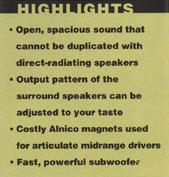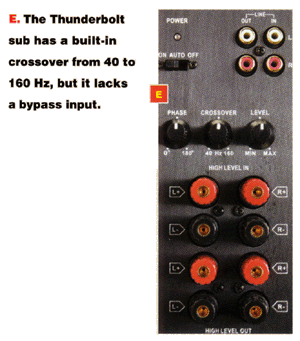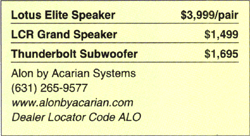
October 2002

High-Performance Home Theater: Decidedly Dipole
The crème de la crème in home theater gear
(Alón Lotus Elite Speaker System)
by Michael Trei



High-Performance Home Theater: Decidedly Dipole
The crème de la crème in home theater gear
(Alón Lotus Elite Speaker System)
by Michael Trei

 One of the finest
exponents of the East Coast sound was a speaker called the DQ-10 from
a high-end company called Dahlquist. Jon Dahlquist had always been a
huge fan of what is my all-time-favorite speaker, the legendary Quad
Electrostatic. With the DQ-10, his goal was to recreate the Quad's
look and sound in a dynamic speaker that was better suited to American
living rooms and listening habits. Dahlquist mounted all of the
drivers except the woofer in free space on an open framework, allowing
the sound to radiate to both the front and rear in a dipole
pattern. The reflected rear wave gave the sound an open, out-of-the
box quality that was quite unlike anything else available at the
time. Sales were strong, and the DQ-10 became one of the first major
success stories from the fledgling U.S. high-end industry. One admirer
was a young speaker designer from New York named Carl Marchisotto, who
eventually joined Dahlquist and went on to design several follow-up
models to the DQ-10, including the DQ-20, DQ-12, and DQ-8. All of
these speakers shared the DQ-10's open-dipole design, but their
woofers were mounted in an enclosure, which allowed for deep, powerful
bass.
One of the finest
exponents of the East Coast sound was a speaker called the DQ-10 from
a high-end company called Dahlquist. Jon Dahlquist had always been a
huge fan of what is my all-time-favorite speaker, the legendary Quad
Electrostatic. With the DQ-10, his goal was to recreate the Quad's
look and sound in a dynamic speaker that was better suited to American
living rooms and listening habits. Dahlquist mounted all of the
drivers except the woofer in free space on an open framework, allowing
the sound to radiate to both the front and rear in a dipole
pattern. The reflected rear wave gave the sound an open, out-of-the
box quality that was quite unlike anything else available at the
time. Sales were strong, and the DQ-10 became one of the first major
success stories from the fledgling U.S. high-end industry. One admirer
was a young speaker designer from New York named Carl Marchisotto, who
eventually joined Dahlquist and went on to design several follow-up
models to the DQ-10, including the DQ-20, DQ-12, and DQ-8. All of
these speakers shared the DQ-10's open-dipole design, but their
woofers were mounted in an enclosure, which allowed for deep, powerful
bass.

As with all of Marchisotto's dipole speakers, the Lotus Elite utilizes conventional box-mounted woofers; the open baffle is dedicated strictly to the midrange and tweeter array. Each of the two 8-inch woofers has its own individually sealed enclosure. To make the combined response smoother, each enclosure is tuned slightly differently. This is a clever, if costly, approach that also eliminates the effect that woofers can have on each other when they're mounted in the same box The 5.25-inch midrange driver uses an expensive Alnico magnet, which is said to provide a smoother, more-natural midrange than a standard ceramic magnet. There's also a Signature version of the Lotus Elite, in which the woofers and tweeters also use Alnico magnets. This upgrade results in a full doubling of the retail price, so you can be sure that this Alnico stuff isn't exactly cheap. Most tweeters have a closed back and radiate from the front; so, to get the dipole output he desired, Marchisotto used a special 1-inch aluminum tweeter with an open-backed pole piece. While there's little question that dipole radiation is largely responsible for these speakers' sonic qualities, Marchisotto feels that another major benefit of this design is the elimination of any potential air resonance and reflections within the midrange enclosure itself.
Alón's cabinetry has always had a distinctly American look, and my review samples came in an attractive cherry veneer with nicely chamfered edges and a smooth satin finish. Alón supplies snap-on grilles for both the front and rear, although Marchisotto feels that, in order to get the very best results, you should use the Lotus Elite au naturel. Triple sets of gold-plated binding posts allow for triwiring, and Alón sent triwired sets of their own Black Orpheus speaker cable along with my review samples. This cable has different types of stranding that's optimized for either high- or low-frequency drivers, yet, because it uses individual conductors for each leg, the overall six-conductor bundle is flexible and easy to manage. To prevent the electrical interference that can occur between the sections of a standard multiway crossover, the Lotus Elite uses three separate circuit boards to split the crossover both physically and electrically. Four adjustable floor spikes support and level the speaker.
Since the LCR Grand speaker that I used for the center and surround channels has the same midrange, tweeter, and open-baffle design, it created a seamless sonic blend with the lotus Elite. In order to retain symmetry in the design, a pair of 6-inch woofers, each with its own separate enclosure, flanks the dipole's baffle-mounted drivers. A common problem with two-way, three-driver center-channel speakers is that the two woofers are likely to create a comb-filtering effect, which produces a ragged response for off-axis listeners. By making the LCR Grand a three-way design, Alón was able to make the midrange-to-woofer crossover low enough to essentially eliminate this problem.
I positioned the LCR Grand speaker vertically for the surround channels, and I placed each one slightly behind the listening position with the drivers pointed directly at me. One neat thing about a dipole speaker is that, by turning the speaker on its axis, you can affect the ratio of direct-to-reflected sound to the point where, at 90 degrees, all of the sound you hear is indirect reflections. By making changes in the angle of the speaker, you'll get big changes in the sonic presentation, allowing you to personalize the sound to an extent.
When Marchisotto set out to design the perfect home theater subwoofer, he decided to steer clear of the current trend of a tiny sub with a small yet massively built driver and a monstrous amplifier. Using a larger 12-inch driver with a very lightweight moving structure in a somewhat-larger enclosure, the Thunderbolt achieves its bass with a much-lower-powered amplifier that is both fast and powerful. To avoid the high levels of inertia that a small but heavily built cone generates, the Thunderbolt's driver responds much more accurately to the signal, kind of like the way a go-kart can turn much more quickly than a large sedan. As a result, the Thunderbolt is much more tuneful than most mini subs, without the one-note quality that results when a driver is constantly trying to overcome its own mass.
 In order to integrate the Thunderbolt into your system, you can make a
number of adjustments. There are both line- and speaker-level
inputs. You can adjust the built-in crossover between 40 and 160
hertz, and the phase is continuously variable through 180 degrees to
help keep the Thunderbolt in step with the other speakers. One
provision that's missing here is a straight, unfiltered line-level
input for those of us who use our processor's built-in
crossover. Alón suggests that you turn up the frequency to its
highest setting to get it out of the signal path. In practice, this
works fine, although a true bypass would've been nicer. Just as
Rolls-Royce once did with their cars, Alón doesn't quote a
power rating for the Thunderbolt, claiming simply that it is "ample"
while pointing out the lightweight driver's high efficiency. In truth,
the Thunderbolt uses a very powerful Class A/B amplifier that's built
more like a good separate amp than one of those cheap
switching-power-supply amps (with their huge theoretical power
ratings) that the mini-subs use.
In order to integrate the Thunderbolt into your system, you can make a
number of adjustments. There are both line- and speaker-level
inputs. You can adjust the built-in crossover between 40 and 160
hertz, and the phase is continuously variable through 180 degrees to
help keep the Thunderbolt in step with the other speakers. One
provision that's missing here is a straight, unfiltered line-level
input for those of us who use our processor's built-in
crossover. Alón suggests that you turn up the frequency to its
highest setting to get it out of the signal path. In practice, this
works fine, although a true bypass would've been nicer. Just as
Rolls-Royce once did with their cars, Alón doesn't quote a
power rating for the Thunderbolt, claiming simply that it is "ample"
while pointing out the lightweight driver's high efficiency. In truth,
the Thunderbolt uses a very powerful Class A/B amplifier that's built
more like a good separate amp than one of those cheap
switching-power-supply amps (with their huge theoretical power
ratings) that the mini-subs use.
Initially, I used the speakers in my home theater setup and fed them the typical demo diet of explosions, mortar fire and zooming spaceships. The results were impressive. The Thunderbolt subwoofer, in particular, captured my attention, adding dramatic impact to low frequency transients. I soon discovered, however, that this type of fodder isn't really what a system like this is all about Many systems can sound impressive with this biff-bang-boom kind of stuff, but it's much more difficult to create a natural, open sound throughout a movie - especially during the quieter scenes - and it's here that you'll appreciate the Alón system's real strengths. Dialogue clarity is particularly impressive, with excellent tonal contrast between different voices, while the sibilants and other high-frequency sounds are very well controlled, particularly when you consider that all of the speakers use metal-dome tweeters.
I tend to prefer the precise front-to-back soundfield transitions that direct-radiating surround speakers produce to the purely ambient sense of space that side-firing dipoles create. With the Alón surrounds, I found that I could get a good sense of both when I used them close to the wall with the front of the speaker firing toward me. The reflected sound from the back of the midrange and tweeter added an extra sense of ambience that you don't normally hear from a conventional box. Because of the ability to vary the ratio of direct-to-reflected sound by turning the speaker, I think pretty much any listener will be able to find a position that gets it right for them.
It was when I used the Lotus Elites as stereo speakers with music that the system's biggest strengths were revealed. There's an impressive transparency through the midrange, as well as a distinct lack of the boxy colorations that afflict many speakers. Even though the rear-firing output reflects a good part of the sound, image focus and specificity remain good, while image depth is expectedly impressive. The Lotus Elite's bass response was tuneful and fast, although it didn't exactly plumb the deepest octave. I used the ultra mode on my B&K Reference 30 pre/pro so that the subwoofer would engage in stereo mode.
 I've used dipole speakers for my music listening for many years. For
home theater, though, I've generally found that a more-conventional
system gives me greater impact and dynamics-qualities that I feel are
particularly important for soundtrack reproduction. With this system,
Alón makes a compelling argument for the universal use of
dipole speakers. By keeping the dipole approach only for the midrange
and high frequencies, they've combined many of the best qualities of
both dipoles and monopoles in one design. For those of you who want to
build a system as much for music as for home theater, this is
certainly an intriguing and intelligent choice.
I've used dipole speakers for my music listening for many years. For
home theater, though, I've generally found that a more-conventional
system gives me greater impact and dynamics-qualities that I feel are
particularly important for soundtrack reproduction. With this system,
Alón makes a compelling argument for the universal use of
dipole speakers. By keeping the dipole approach only for the midrange
and high frequencies, they've combined many of the best qualities of
both dipoles and monopoles in one design. For those of you who want to
build a system as much for music as for home theater, this is
certainly an intriguing and intelligent choice.